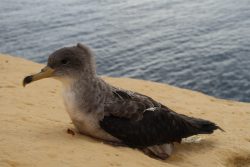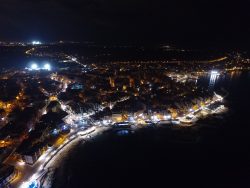BirdLife Malta is calling on the public to look out for any stranded seabirds that may have become disorientated when fledging for the first time. At this time of year, young Scopoli’s Shearwaters fledge and leave their remote cliff-side nesting locations for the open sea. However, the light pollution from bright coastal lights can leave these young seabirds disorientated increasing their chances of becoming stranded inland in roads, seafronts, ports, towns, and other urbanised areas. Once they are stranded they are unable to fly back out to sea – where they spend the majority of their lives – putting their survival in danger.
As in the past fledging seasons of these secretive birds, we are calling on the public to report any sightings or findings of stranded Scopoli’s Shearwaters to BirdLife Malta.

This applies especially for the days between the 14th and 24th of October which are considered as the peak period for strandings, although the period can last until the beginning of November. Stranded birds are most likely to be encountered in the early morning or late evening in localities like Pembroke, Birżebbuġa, Ħal Far and Ċirkewwa in Malta; and Xlendi and Mġarr in Gozo. However, they could may turn up in almost any location.
Where possible, stranded birds should be collected and gently placed in a cardboard box. The birds should not be given any food or water, but kept in a quiet place until they are retrieved by BirdLife Malta staff to be safely released back at sea. BirdLife Malta can be reached on 2134 7644 (office hours) or 7925 5697 (emergency out of office).
BirdLife Malta calls on the public to rescue stranded seabird fledglings which become disorientated due to light pollution
The Scopoli’s Shearwater, the larger of the two shearwater species, has an estimated population of slightly less than 4,000 pairs in Malta – approximately 2% of the world breeding population. This protected species of seabird, which can be recognised by its grey-brown back with white underbelly and yellow bill, can often be seen ‘shearing’ over the tops of waves.
BirdLife Malta’s LIFE Arċipelagu Garnija project is working to reduce the impacts of light pollution close to the colonies to ensure long-term protection of seabirds. Last year was a record year with 24 stranded Scopoli’s Shearwater reported by the public. It is only with the support of the public who report the stranding of young seabird chicks that BirdLife Malta is able to rescue and release them back into safe locations at night, allowing them to continue with their journey at sea. These reports also contribute to BirdLife Malta’s long-term dataset on stranded birds, which is valuable to show the correlation between number of stranded birds and increasing level of lights across the Maltese Islands.
Read the Maltese version of the press release here. Click below to watch a video about light pollution and its impacts on Malta’s breeding seabirds.

